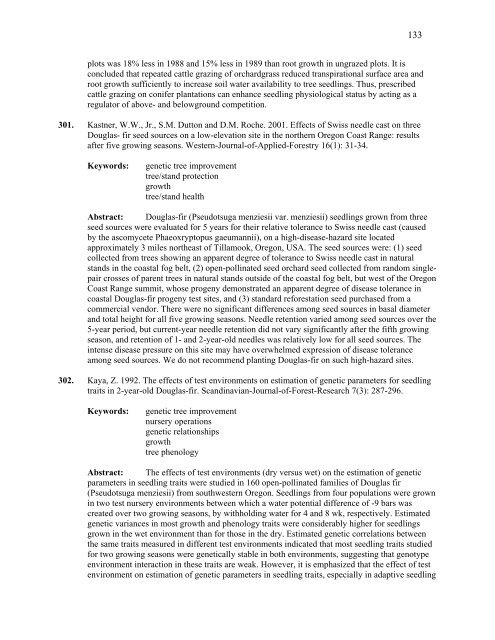IntensIve sIlvIculture - Forest Science Labs - Research Network ...
IntensIve sIlvIculture - Forest Science Labs - Research Network ...
IntensIve sIlvIculture - Forest Science Labs - Research Network ...
Create successful ePaper yourself
Turn your PDF publications into a flip-book with our unique Google optimized e-Paper software.
133<br />
plots was 18% less in 1988 and 15% less in 1989 than root growth in ungrazed plots. It is<br />
concluded that repeated cattle grazing of orchardgrass reduced transpirational surface area and<br />
root growth sufficiently to increase soil water availability to tree seedlings. Thus, prescribed<br />
cattle grazing on conifer plantations can enhance seedling physiological status by acting as a<br />
regulator of above- and belowground competition.<br />
301. Kastner, W.W., Jr., S.M. Dutton and D.M. Roche. 2001. Effects of Swiss needle cast on three<br />
Douglas- fir seed sources on a low-elevation site in the northern Oregon Coast Range: results<br />
after five growing seasons. Western-Journal-of-Applied-<strong>Forest</strong>ry 16(1): 31-34.<br />
Keywords: genetic tree improvement<br />
tree/stand protection<br />
growth<br />
tree/stand health<br />
Abstract: Douglas-fir (Pseudotsuga menziesii var. menziesii) seedlings grown from three<br />
seed sources were evaluated for 5 years for their relative tolerance to Swiss needle cast (caused<br />
by the ascomycete Phaeoxryptopus gaeumannii), on a high-disease-hazard site located<br />
approximately 3 miles northeast of Tillamook, Oregon, USA. The seed sources were: (1) seed<br />
collected from trees showing an apparent degree of tolerance to Swiss needle cast in natural<br />
stands in the coastal fog belt, (2) open-pollinated seed orchard seed collected from random singlepair<br />
crosses of parent trees in natural stands outside of the coastal fog belt, but west of the Oregon<br />
Coast Range summit, whose progeny demonstrated an apparent degree of disease tolerance in<br />
coastal Douglas-fir progeny test sites, and (3) standard reforestation seed purchased from a<br />
commercial vendor. There were no significant differences among seed sources in basal diameter<br />
and total height for all five growing seasons. Needle retention varied among seed sources over the<br />
5-year period, but current-year needle retention did not vary significantly after the fifth growing<br />
season, and retention of 1- and 2-year-old needles was relatively low for all seed sources. The<br />
intense disease pressure on this site may have overwhelmed expression of disease tolerance<br />
among seed sources. We do not recommend planting Douglas-fir on such high-hazard sites.<br />
302. Kaya, Z. 1992. The effects of test environments on estimation of genetic parameters for seedling<br />
traits in 2-year-old Douglas-fir. Scandinavian-Journal-of-<strong>Forest</strong>-<strong>Research</strong> 7(3): 287-296.<br />
Keywords: genetic tree improvement<br />
nursery operations<br />
genetic relationships<br />
growth<br />
tree phenology<br />
Abstract: The effects of test environments (dry versus wet) on the estimation of genetic<br />
parameters in seedling traits were studied in 160 open-pollinated families of Douglas fir<br />
(Pseudotsuga menziesii) from southwestern Oregon. Seedlings from four populations were grown<br />
in two test nursery environments between which a water potential difference of -9 bars was<br />
created over two growing seasons, by withholding water for 4 and 8 wk, respectively. Estimated<br />
genetic variances in most growth and phenology traits were considerably higher for seedlings<br />
grown in the wet environment than for those in the dry. Estimated genetic correlations between<br />
the same traits measured in different test environments indicated that most seedling traits studied<br />
for two growing seasons were genetically stable in both environments, suggesting that genotype<br />
environment interaction in these traits are weak. However, it is emphasized that the effect of test<br />
environment on estimation of genetic parameters in seedling traits, especially in adaptive seedling
















